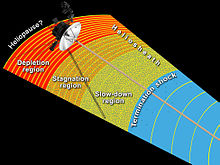Outer limits

The solar wind "blows a bubble" in the interstellar medium (the rarefied hydrogen and helium gas that permeates the galaxy). The point where the solar wind's strength is no longer great enough to push back the interstellar medium is known as the heliopause and is often considered to be the outer border of the Solar System. The distance to the heliopause is not precisely known and probably depends on the current velocity of the solar wind and the local density of the interstellar medium, but it is far outside Pluto's orbit. Scientists hope to gain perspective on the heliopause from data acquired through the Interstellar Boundary Explorer (IBEX) mission, launched in October 2008.
The end of the heliosphere is noted as one of the ways defining the extent of the Solar System, along with the Kuiper Belt, and finally the radius at which of the Sun's gravitational influence is matched by other stars. The maximum extent of that influence has been estimated at between 50,000 AU and 2 light-years, compared to the edge of the heliopause (the outer edge of the heliosphere), which has been detected to end about 120 AU by the Voyager 1 spacecraft.
The Voyager 2 spacecraft crossed the shock more than five times between August 30 and December 10, 2007. Voyager 2 crossed the shock about a Tm closer to the Sun than the 13.5 Tm distance where Voyager 1 came upon the termination shock. The spacecraft moved outward through the termination shock into the heliosheath and onward toward the interstellar medium.
Comments
Post a Comment